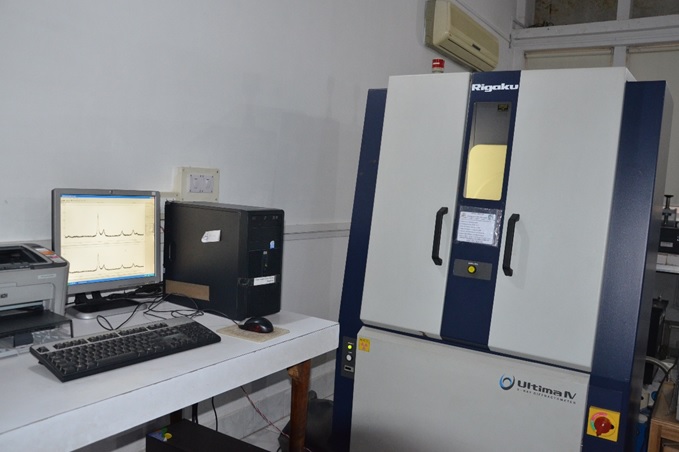





Sophisticated Analytical Instruments Facility
| Name of the equipment/facility: Powder X-Ray Diffrctrometer |  |
||||||||||||||||||||||||||||||||||||||||||||||||
| Make: Rigaku, Japan | |||||||||||||||||||||||||||||||||||||||||||||||||
| Model: ULTIMA IV | |||||||||||||||||||||||||||||||||||||||||||||||||
| Specification: | |||||||||||||||||||||||||||||||||||||||||||||||||
|
|||||||||||||||||||||||||||||||||||||||||||||||||
| Working Principle: | |||||||||||||||||||||||||||||||||||||||||||||||||
| X-ray diffraction (XRD) is one of the most important non-destructive tools to analyze all kinds of matter—ranging from fluids, to powders and crystals. XRD is an indispensable method for materials characterization from basic lab scale research to production and engineering
X-ray diffraction techniques are used for the identification of crystalline phases of various materials and the quantitative phase analysis subsequent to the identification. X-ray diffraction techniques are superior in elucidating the three-dimensional atomic structure of crystalline solids. The properties and functions of materials largely depend on the crystal structures. X-ray diffraction techniques have, therefore, been widely used as an indispensable means in materials research, development and production.
The Bragg equation, nλ = 2dsinθ is one of the keystones in understanding X-ray diffraction. Where n is an integer, λ is the characteristic wavelength of the X-rays impinging on the crystallize sample, d is the interplanar spacing between rows of atoms, and θ is the angle of the X-ray beam with respect to these planes. When this equation is satisfied, X-rays scattered by the atoms in the plane of a periodic structure are in phase and diffraction occurs in the direction defined by the angle θ. In the simplest instance, an X-ray diffraction experiment consists of a set of diffracted intensities and the angles at which they are observed. This diffraction pattern can be thought of as a chemical fingerprint, and chemical identification can be performed by comparing this diffraction pattern to a database of known patterns.
| |||||||||||||||||||||||||||||||||||||||||||||||||
| Applications: | |||||||||||||||||||||||||||||||||||||||||||||||||
| • X-ray powder diffraction is most widely used for the identification of unknown crystalline materials (e.g. ore, minerals, inorganic compounds, nanomaterials).Determination of unknown solids is critical to studies in geology, environmental science, material science, engineering, and biology.
• Characterization of crystalline materials
• Identification of fine-grained minerals such as clays and mixed layer clays that are difficult to determine optically
• Determination of unit cell dimensions
• Measurement of sample purity
• Particle size distribution by SAXS analysis
• Crystalline phase identification
• Chemical composition by Rietveld analysis
| |||||||||||||||||||||||||||||||||||||||||||||||||
| User Instructions: | |||||||||||||||||||||||||||||||||||||||||||||||||
| • External Users (Other than CSIR):
a) External users should download the requisite registration form and submit it to the institute along with the demand draft or online payment copy. The sample should be submitted on the day of theallotted time slot. The analysis will be performed on the next day and result will be sent through email.
b) Approximately 1 gm of the dry powder sample is required for the single measurement.
c) The sample should be ground to fine powder. Powdered sample less than ~10 μm(or 200mesh)in size is preferred.
d) Users desiring to get back the sample need to mark the form. Collect them after two-three days after completion of the analysis otherwise, they will be treated as unwanted and will be disposed of after one weak of intimation of the completion of the work and no reminder will be sent.
• . Internal Users:
a) Users should submit the sample to Room No -1 of Advanced Materials group Laboratory along with the requisition form.
b) Approximately 1 gm of the dry powder sample is required for the single measurement.
c) The sample should be ground to fine powder. Powdered sample less than ~10 μm(or 200mesh)in size is preferred.
d) Users desiring to get back the sample should collect their samples within two-three days after the analysis otherwise they will be believedas unwanted and disposed of.
e) Users are encouraged to be present during analysis of their samples.
|
|||||||||||||||||||||||||||||||||||||||||||||||||
| Contact | |||||||||||||||||||||||||||||||||||||||||||||||||
| 1. Dr Manash R Das, Scientist, mrdas@neist.res.in, mnshrdas@yahoo.com, 9957178399 | |||||||||||||||||||||||||||||||||||||||||||||||||
| Charges (Excluding Taxes) | |||||||||||||||||||||||||||||||||||||||||||||||||
|
|||||||||||||||||||||||||||||||||||||||||||||||||